Cascadia Research will be undertaking a ~3 week field project off the island of Kaua‘i starting July 20th, 2011. This will be our fifth field project (and fourth year) working off Kaua‘i and Ni‘ihau, and our most extensive effort there since 2005. The primary purpose of the project is to obtain information on movements and habitat use of a number of species of toothed whales through the deployment of satellite tags. After the end of our field project the Navy will be carrying out a Submarine Commanders Course (SCC) off the island, and we are hoping to use information on the movements of tagged individuals before, during and after the SCC, to help understand what species may react to navy sonar exercises, what types of reactions occur (e.g., moving out of the area), and the duration and the magnitude of the response. We will also be obtaining photos from most species of odontocetes we encounter, to contribute to ongoing studies of residency patterns and social organization and to estimate population sizes. We will also be collecting biopsy samples for toxicology and genetic studies.We hope to have higher encounter rates than normal since we’ll be working in collaboration with the Marine Mammal Monitoring on Navy Ranges (M3R) program, using the Navy’s hydrophone range off Kaua‘i (see map below) to localize animals. When on the water we will be in constant contact with Navy researchers from the M3R program to help direct us to groups that they are detecting acoustically. This will allow us to confirm the species (to aid in using the acoustic range for research purposes on different species), and should make it much easier for us to find groups of whales and dolphins for tagging, photo-ID and biopsy sampling.
Species that we are hoping to satellite tag include false killer whales, short-finned pilot whales, melon-headed whales, pygmy killer whales, Cuvier’s beaked whales, and Blainville’s beaked whales. Off Kaua‘i we have previously done a small amount of satellite tagging work in 2008 and in February 2011, but those efforts were restricted to two species (short-finned pilot whales and melon-headed whales), and relatively little is known about odontocetes off Kaua‘i in comparison to off the island of Hawai‘i.
The research team includes Daniel Webster, Jessica Aschettino, Elisa Weiss, and Robin Baird of Cascadia, Renee Albertson of Oregon State University, and a number of volunteers. This work is primarily being funded by a grant from the Naval Postgraduate School (funded by N45), as well as additional support from Commander, Pacific Fleet, and the Pacific Islands Fisheries Science Center of NOAA Fisheries.
The most recent updates are at the top of page
End of project update
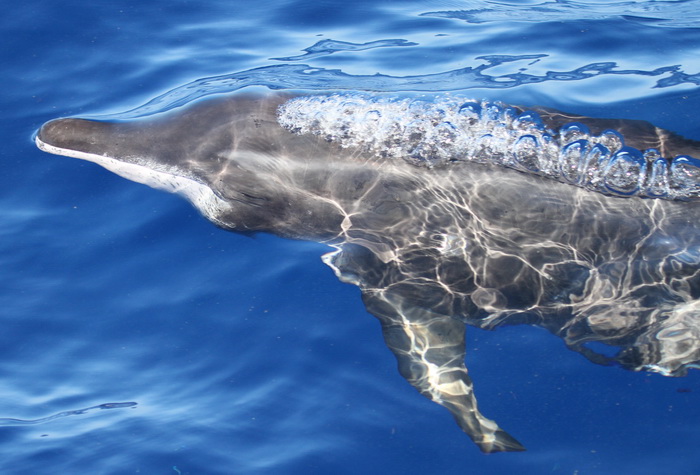
Rough-toothed dolphin, August 8, 2011. Photo by Elisa Weiss.
August 8th was our last day on the water. In our 18 days on the water this trip we covered 1,972 kilometers, and had 65 sightings of five species of odontocetes, more than half (33) of which were rough-toothed dolphins. During this effort we took 22,615 photos for individual and species identification, collected 48 biopsy samples for genetics and toxicology, and deployed four satellite tags. While the weather was not as cooperative as we had hoped it might be, and we weren’t able to spend as much time in deep water as we wanted to, overall it was a productive trip.
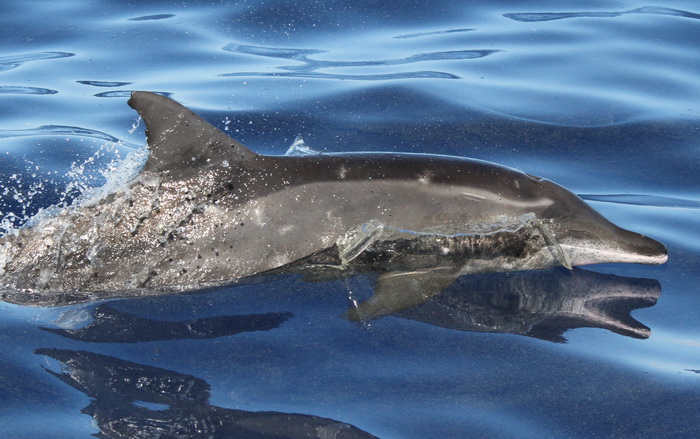
Rough-toothed dolphin, August 8, 2011. Photo by Ali Bayless. On our last day out we encountered three species, including a group of about 14 rough-toothed dolphins. We were able to photo-identify most of the individuals present and obtained two biopsy samples, bringing the total number of biopsy samples from rough-toothed dolphins this trip to 23. These samples will be used by Ph.D. student Renee Albertson from Oregon State University as part of a study of rough-tooted dolphin population structure in the Pacific Ocean.
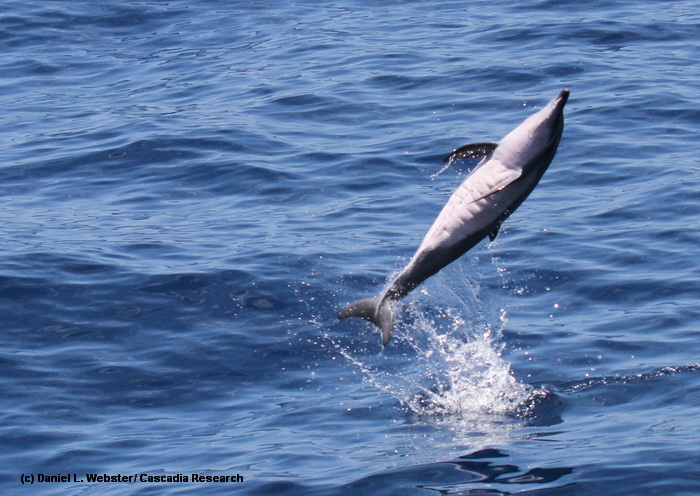
Spinner dolphin neonate learning how to spin, August 8, 2011. Photo by Daniel Webster. We also encountered a group of spinner dolphins off of Polihale. Although spinners were our second-most frequently encountered species of the trip (15 sightings), many of those sightings were of groups encountered in the same general area off Polihale, a traditional resting area for spinners.
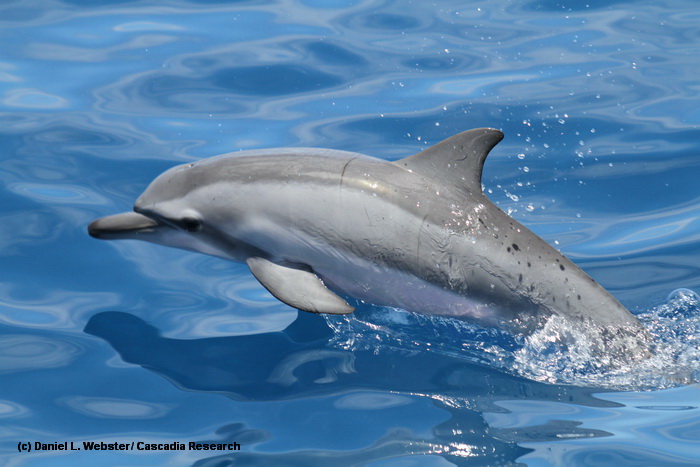
Spinner dolphin neonate, August 8, 2011. Photo by Daniel Webster.
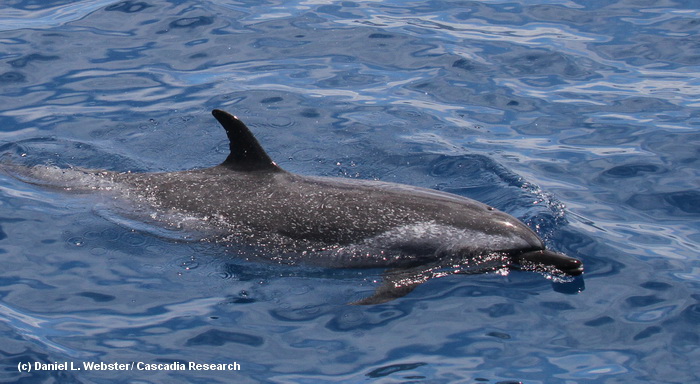
Pantropical spotted dolphin, August 8, 2011. Photo by Daniel Webster. The lone spotted dolphin was also seen in the group of spinners again.
August 5 update
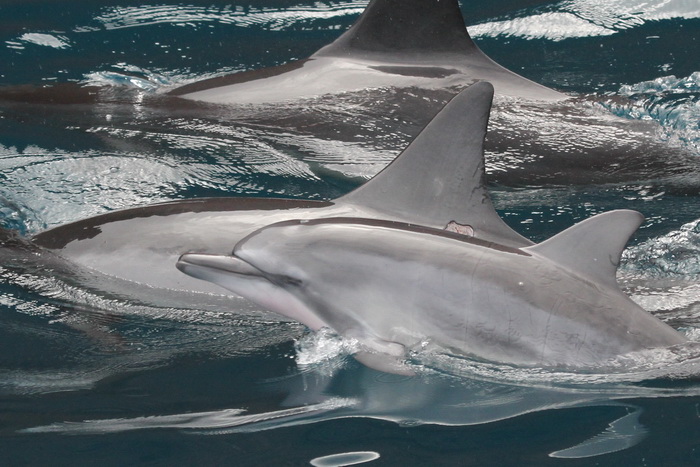
A newborn spinner dolphin next to it’s mother, August 5, 2011. The fetal folds are still visible on this calf. Photo by Elisa Weiss.
Today the winds were forecast at 25 knots from the east, and this time the weather forecasters were correct. The strong winds kept us restricted to the nearshore waters off the east end of the island, where we encountered a pair of bottlenose dolphins and a large group of spinner dolphins (with the spotted dolphin present from yesterday still with them). We are also getting numerous locations each day from the four dolphins tagged to date (see below).
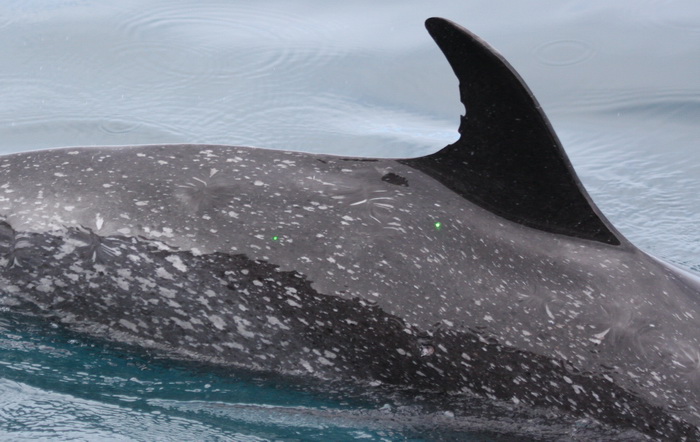
Pantropical spotted dolphin, August 5, 2011. Photo by Jessica Aschettino. The white lines radiating out from a central point (far left and just below and behind dorsal fin) are areas where the spotting pattern has been disrupted by bites from cookie-cutter sharks.
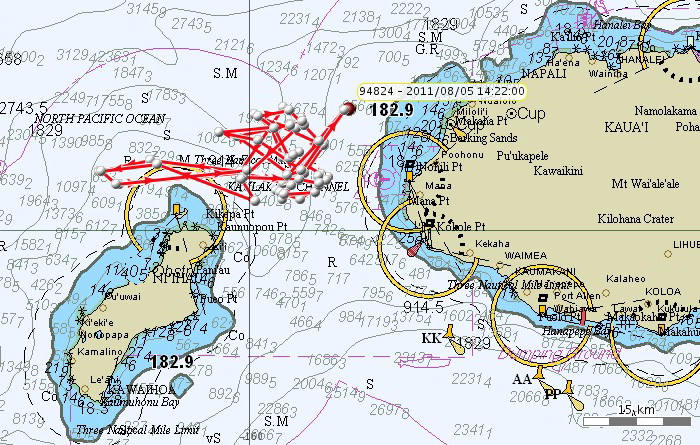
Map showing the movements of two satellite-tagged rough-toothed dolphins over the 4 days since tagging. While the map shows only high quality locations, the locations have not yet been filtered to take into account travel speed, thus final positions may change.
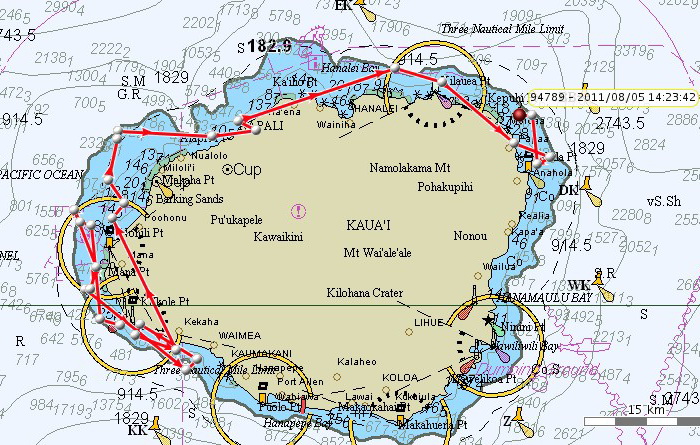
Map showing the movements of the satellite-tagged bottlenose dolphin since tagging. While the map shows only high quality locations, the locations have not yet been filtered to take into account travel speed, thus final positions may change.
August 4 update
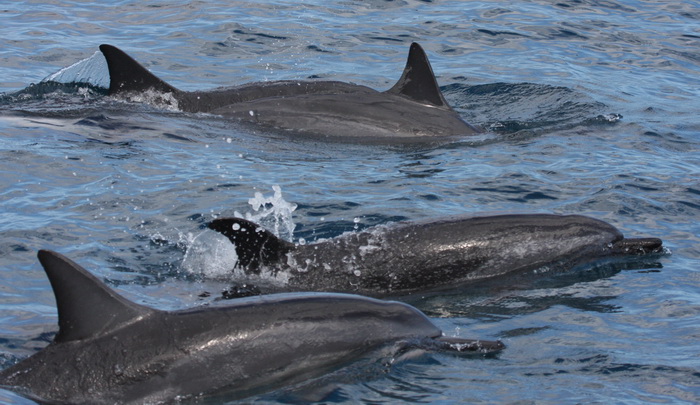
On our 14th day on the water we encountered our fifth species of cetacean for the trip, a lone pantropical spotted dolphin, mixed in with a group of spinner dolphins. Photo by Jessica Aschettino. Note the relatively small dorsal fin of the spotted dolphin (2nd closest individual), and short robust rostrum, as well as the spots. Although pantropical spotted dolphins are very common in Hawaiian waters (they are the second-most-frequently encountered species in our work in general), they are quite rare off of Kaua‘i and Ni‘ihau. For more information on spotted dolphins in Hawai‘i see our web page for that species.
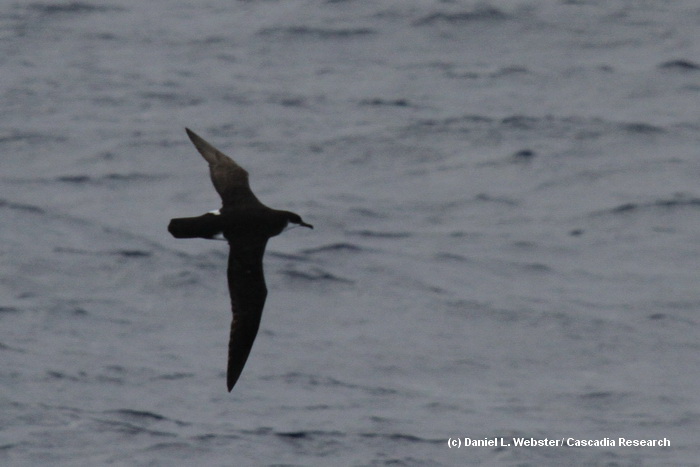
Newell’s Shearwater, August 4, 2011. Photo by Daniel Webster
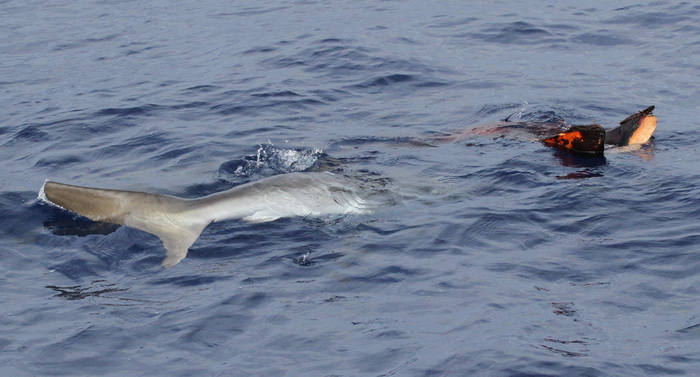
Our most unusual sighting of the day, a shark mouthing a floating palm frond. Photo by Elisa Weiss. There were at least four different sharks circling and mouthing this palm frond.
August 3 update
Today we encountered a group of about 45 bottlenose dolphins off Kaua‘i. We were able to satellite tag one individual, photo-identify most of the individuals present, and obtain six biopsy samples for genetics and toxicology.
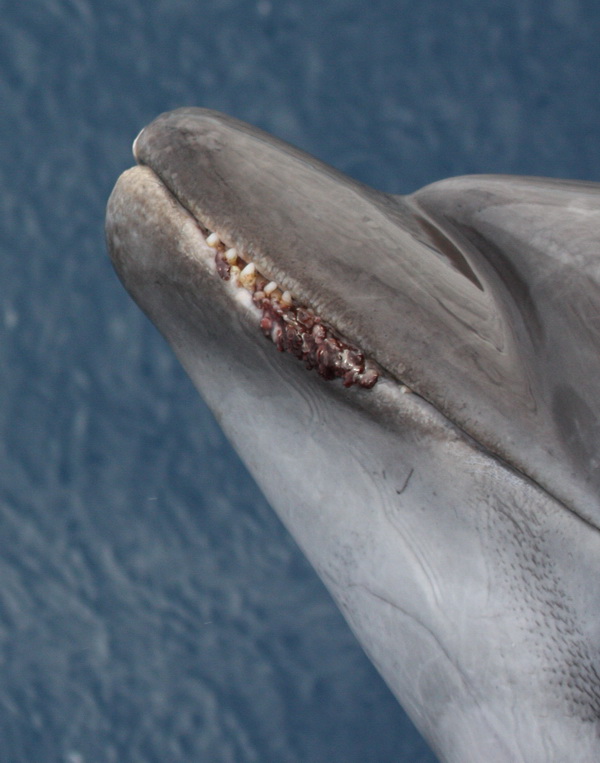
A bottlenose dolphin with teeth protruding from it’s lower jaw, either due to an injury or a congenital defect. The purple objects extending from the mouth are stalked barnacles (probably Xenobalanus) that have attached to the exposed teeth. Photo by Jessica Aschettino.
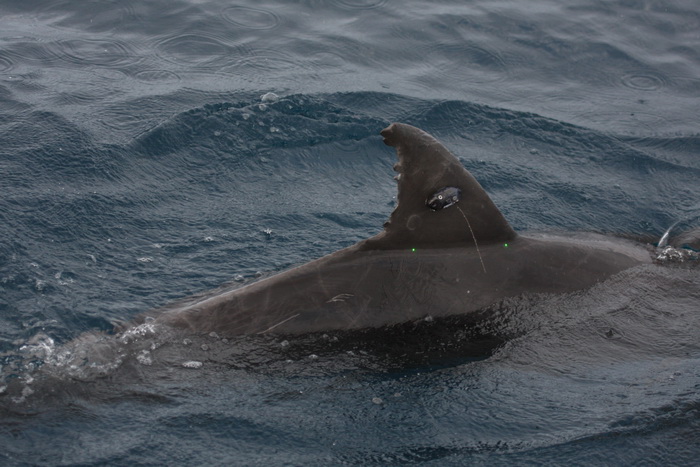
A bottlenose dolphin with satellite tag, August 3, 2011. Photo by Jessica Aschettino. After tagging this individual re-approached our boat and continued to bowride, allowing us to get good photographs. The two green dots are from a green-dot laser photogrammetry system and are 15 cm apart.
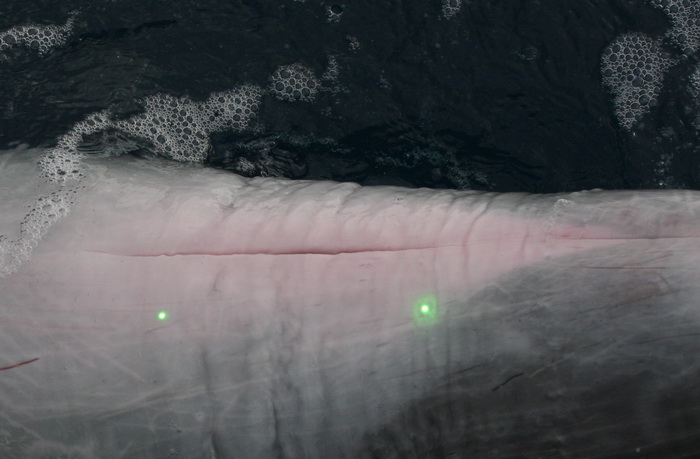
While bowriding after it was tagged, this individual rolled over next to our boat, showing it’s genital slit (it is a male). Photo by Jessica Aschettino. The green dots from the laser photogrammetry system are also visible.
August 2 update
Unfortunately today was our last day working with the M3R researchers using the hydrophone range to find cetaceans, and we were directed to a number of groups of dolphins, all of which turned out to be rough-toothed dolphins. We were able to deploy two additional satellite tags on individuals in one group, including one individual (see below) that we had previously documented off the island.
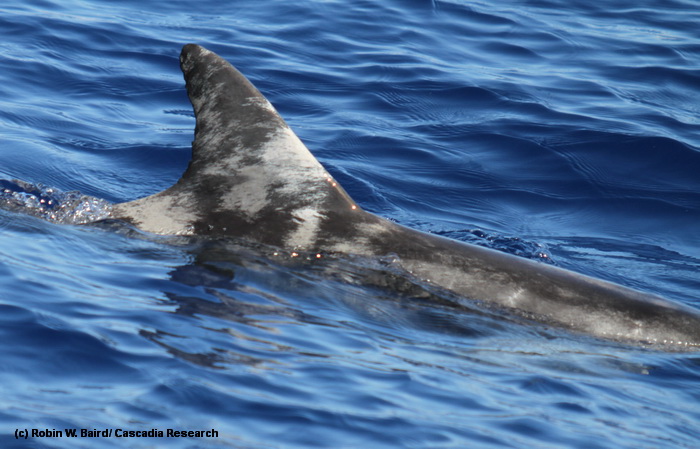
A piebald rough-toothed dolphin, August 2, 2011. Photo by Robin Baird. This individual, designated HISb0785 in our photo-ID catalog, has been previously documented between Kaua‘i and Ni‘ihau on three different occasions, twice in 2007 (by Chris Bane) and once in 2008 (during our June/July 2008 project)
July 31 update
Yesterday morning we launched our boat only to discover a throttle cable had broken, and we ended up spending the day on land. Today with the cable replaced we made it out of the harbor (our 600th day on the water in Hawai‘i in the last 12 years) and onto the range, where we had three encounters with rough-toothed dolphins, and one encounter with bottlenose dolphins.
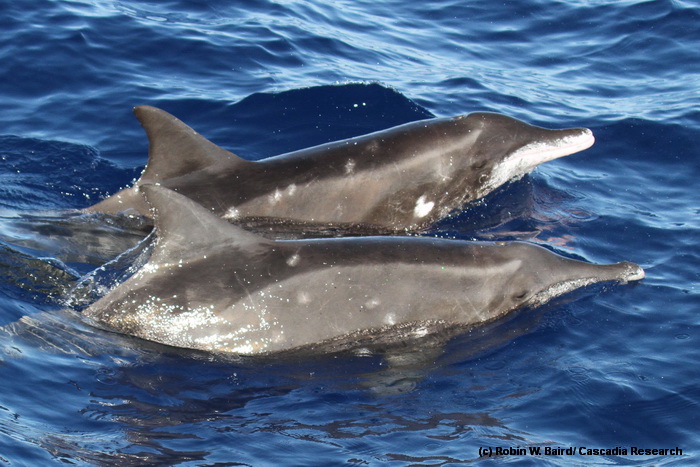
Rough-toothed dolphins, July 31, 2011. Photo by Robin Baird. The white oval scars on these individuals are from cookie-cutter shark bites. The rough-toothed dolphins today were very cooperative, with most of the individuals bowriding on our research vessel. We were able to collect three biopsy samples and photo-identify about 35 different individuals. We were also able to deploy a satellite tag on one individual.
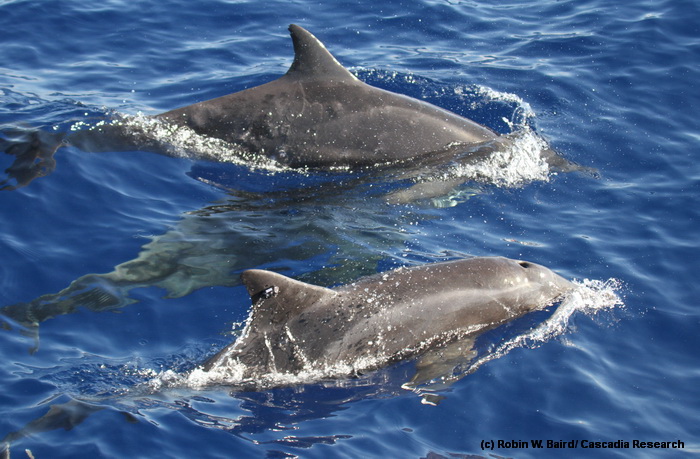
Rough-toothed dolphins – the close individual with a satellite tag on the dorsal fin, July 31, 2011. Photo by Robin Baird. This is the first time we’ve deployed a satellite tag on a rough-toothed dolphin, and possibly the first satellite tag deployed on a free-ranging rough-toothed dolphins (several rough-toothed dolphins in the Atlantic that had stranded and were rehabilitated were satellite tagged before they were released). If the tag continues to transmit we hope to get the first detailed information on movement patterns of rough-toothed dolphins in Hawai‘i. From our photo-identification work we have evidence of at least two populations of rough-toothed dolphins in Hawaiian waters, but our photo-ID data are primarily from off the island of Hawai‘i and off Kaua‘i and Ni‘ihau, so are limited in our assessment of movement patterns.
July 28 update
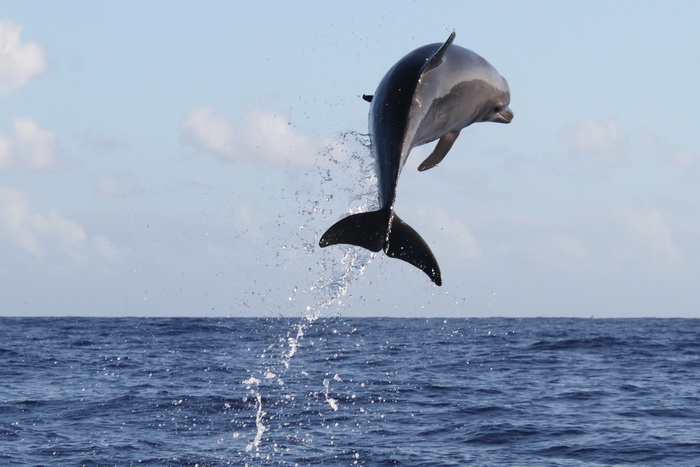
Bottlenose dolphin leaping, July 28, 2011. Photo by Jochen Zaeschmar
Today we encountered our largest group ever of bottlenose dolphins in Hawai‘i, a group of approximately 200 individuals. Prior to today our largest encounter with this species in Hawai‘i was only about 40 individuals, and the entire abundance estimate for this species off the islands of Kaua‘i and Ni‘ihau, based on mark-recapture analysis of photo-identification data, was less than 200 individuals, thus we suspect this may have been a group of offshore animals moving through the area. We were able to collect 6 biopsies and photo-identify many of the individuals, so hope to be able to assess whether this group was part of an offshore or insular population. For more information on bottlenose dolphins in Hawai‘i see our web page for that species.
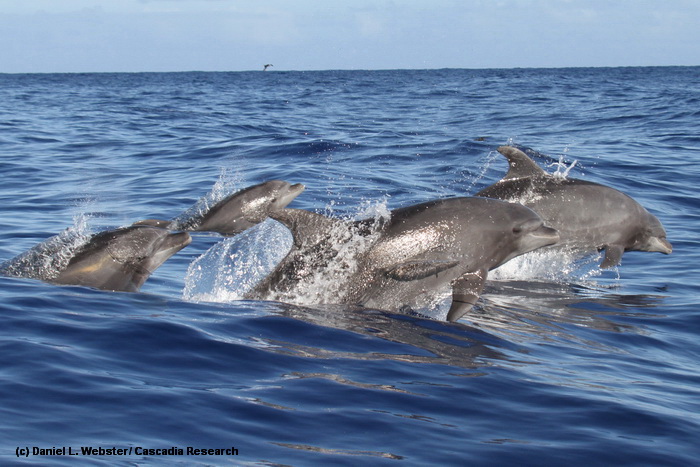
Bottlenose dolphins high speed swimming, July 28, 2011. Photo by Daniel Webster.
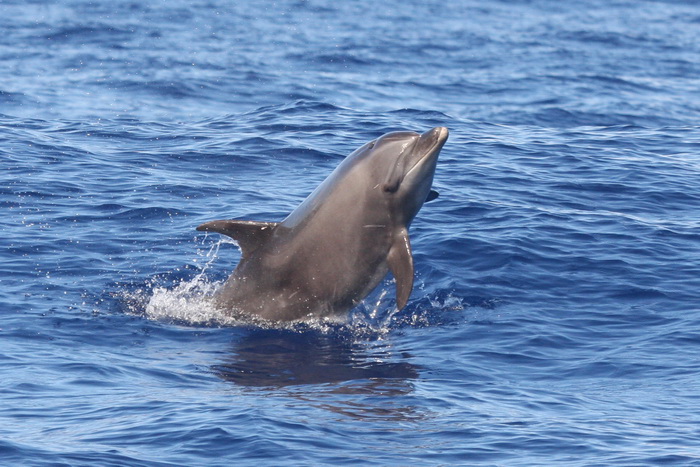
Bottlenose dolphin leaping, July 28, 2011. Photo by Renee Albertson.
July 27 update
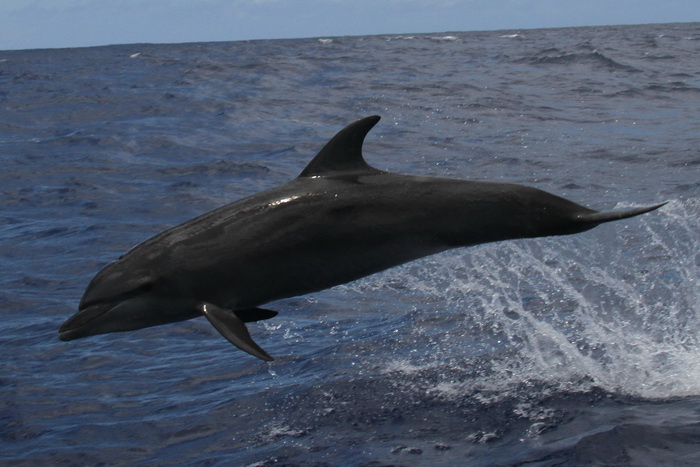
Bottlenose dolphin leaping, July 27, 2011. Photo by Jessica Aschettino.
Although the weather today was not as cooperative, we were able to find three groups of rough-toothed dolphins and one group of bottlenose dolphins. Still none of our high priority species for tagging, we are hoping for better luck in the next few days!
July 26 update
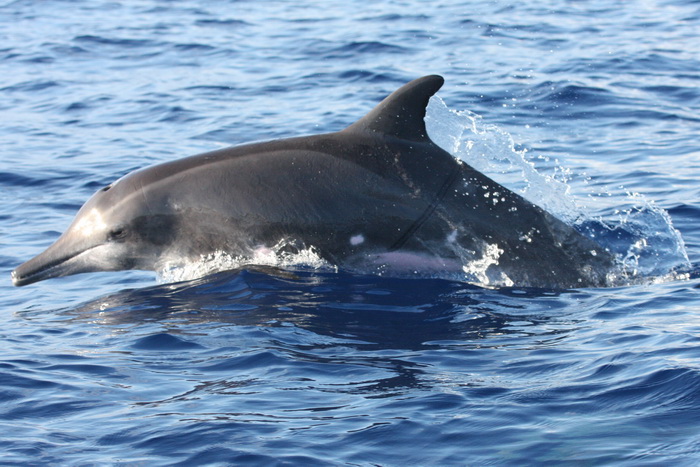
Today we had the calmest conditions for the trip so far, mostly Beaufort 1 and 2 sea conditions, and covered 165 kilometers off the west and north side of Kaua‘i, but only encountered one group of rough-toothed dolphins. We were able to photo-identify most of the individuals present and collected one biopsy sample for genetic studies. Photo by Jessica Aschettino, July 26, 2011.
July 25 update
Although we did not see killer whales again today we did see two groups of bottlenose dolphins, were able to photo identify about 15 different individuals, and collected three biopsy samples for genetics and toxicology. We were also able to swing by Lehua Island, off the north end of Ni‘ihau, and had a good look at four monk seals and many of the seabirds nesting on Lehua.
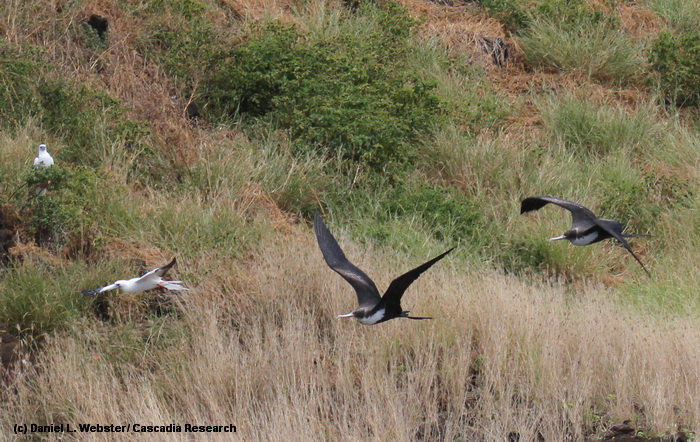
Two Great Frigatebirds chasing a Red-footed Booby at Lehua Island, July 25, 2011. Photo by Daniel Webster
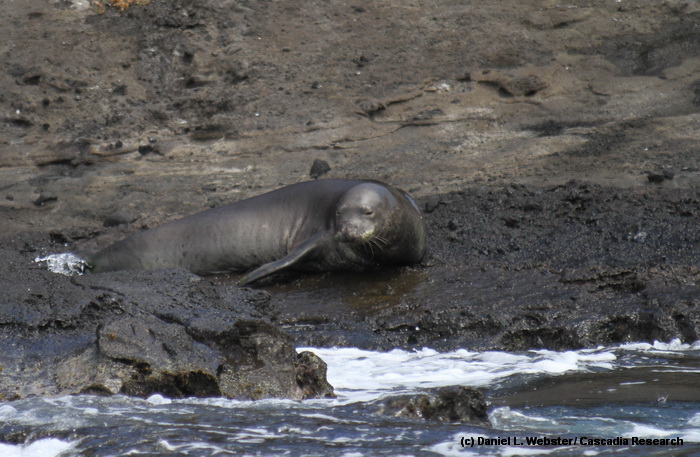
Hawaiian monk seal hauled out on Lehua Island, July 25, 2011. Photo by Daniel Webster
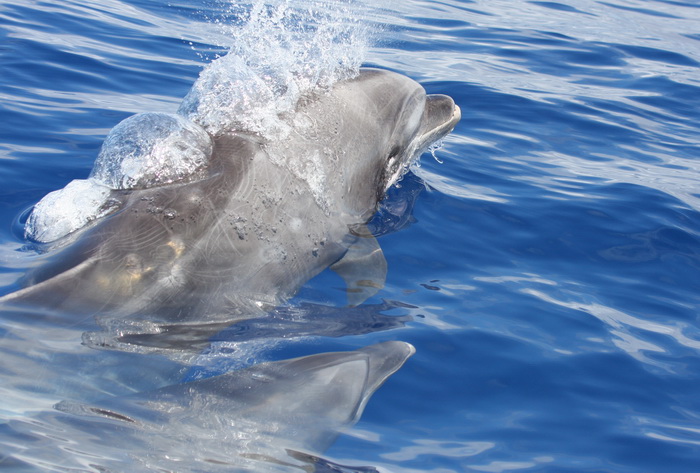
Bottlenose dolphins off Lehua Island, July 25, 2011. Photo by Renee Albertson.
July 24 update
In 12 years of working on the water in Hawai‘i we’ve had over 1,500 encounters with 18 different species of odontocetes. Prior to today we had only seen killer whales once (on May 10, 2002, off Kona). Today we had our second sighting, a group of four seen mid-way between Kaua‘i and Ni‘ihau.
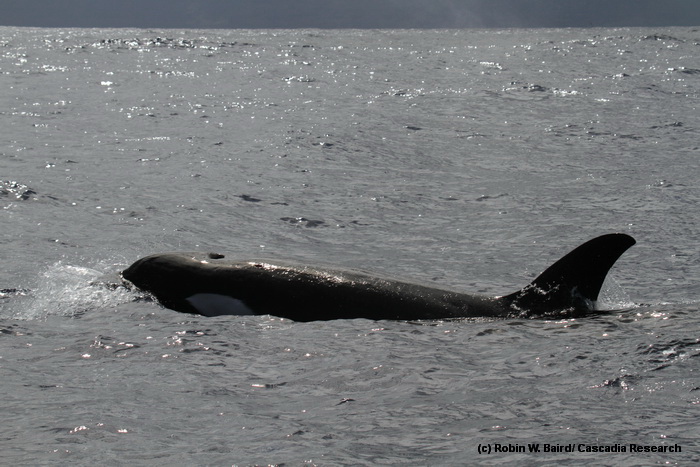
Adult female-sized killer whale off Kaua‘i, July 24, 2011. Photo by Robin Baird. Note the fresh wound, from a cookie-cutter shark bite, behind the blowhole. At the start of the encounter a single rough-toothed dolphin was seen in close proximity to one of the whales – although we were not close enough to confirm whether the dolphin was killed and eaten, the killer whales were moving at high speed immediately behind the dolphin as if it was a predation event.
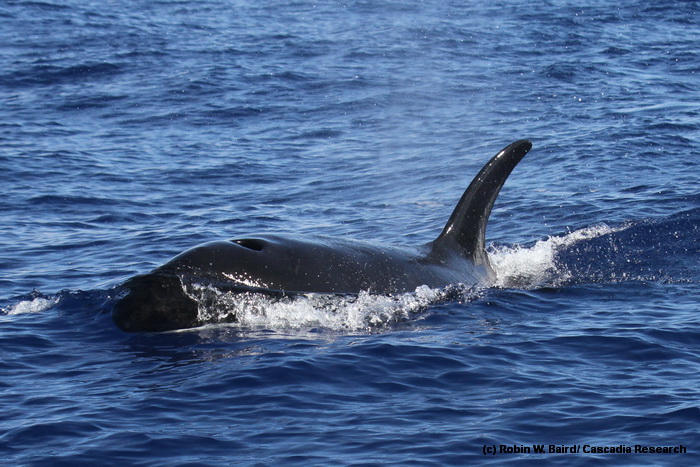
Killer whale seen off Kaua‘i, July 24, 2011. Photo by Robin Baird. We were able to photo-identify all four individuals, and will compare them to our (very small) catalog of killer whales from the islands. From our Hawai‘i killer whale page “There is no evidence of a “resident” population of killer whales in Hawai‘i – whales seen around the main Hawaiian Islands are likely part of a wide-ranging population that inhabits the central Pacific. There are some physical differences from killer whales seen in Hawai‘i compared to the well-known populations along the west coast of North America. The saddle patch (the gray area below and behind the dorsal fin) is very narrow in killer whales in Hawai‘i, and also not very bright (i.e., difficult to see except in ideal light conditions).”
Although we were set up for satellite tagging, we were not able to get close enough to deploy a tag. Hopefully we won’t have to wait another 8 years before our next sighting of this species in Hawai‘i!
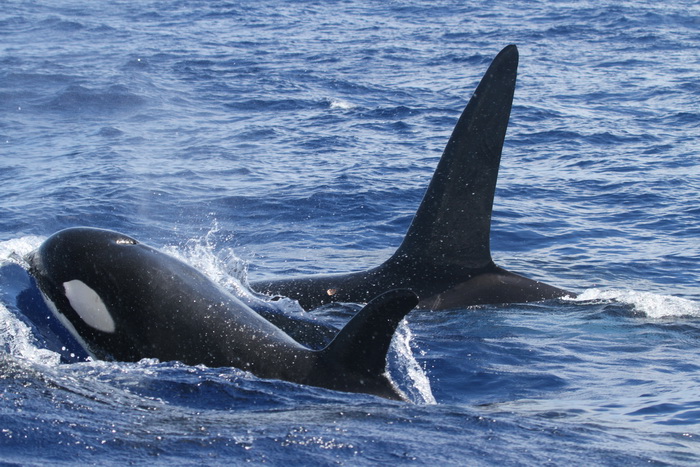
Adult male and sub-adult killer whales off Kaua‘i, July 24, 2011. Photo by Elisa Weiss. Killer whales in Hawai‘i do not appear to have such extreme sexual dimorphism in fin size as found in more temperate and coastal populations.
July 23 update
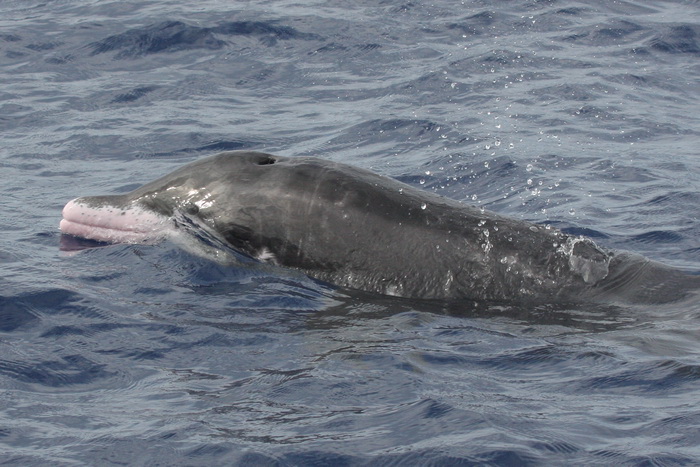
A rough-toothed dolphin with a white rostrum, July 23, 2011 – the white rostrum is typical of older individuals. Photo by Renee Albertson
Today was our calmest day yet, which, working in the channel between Kaua‘i and Ni‘ihau, roughly translates as being able to get out to mid-channel for a short while before the winds wrapping around the north and south side of Kaua‘i made finding or working with cetaceans almost impossible. The forecast the last three days has called for winds from the east at 20 knots – today the forecast was accurate, but we still had a ~4 hour period in the morning where we were able to work on the southern part of the hydrophone range.
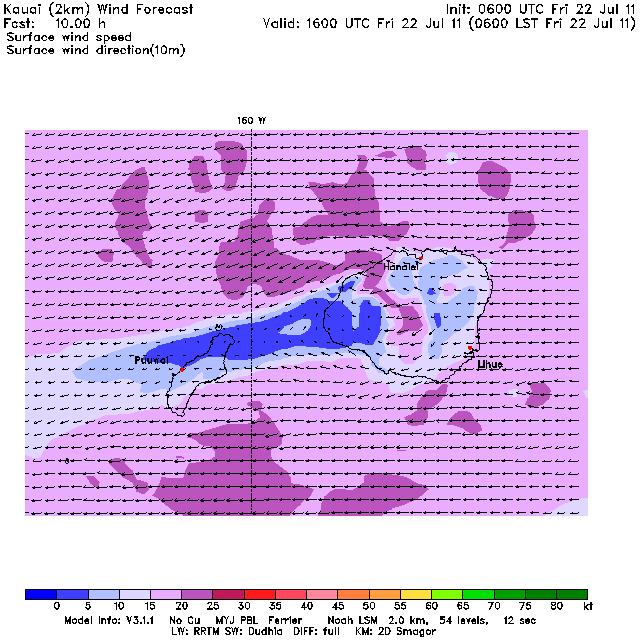
A graphical wind forecast for 6 AM HST July 23, 2011, from http://weather.mhpcc.edu/wrf/kauai2/wind.html
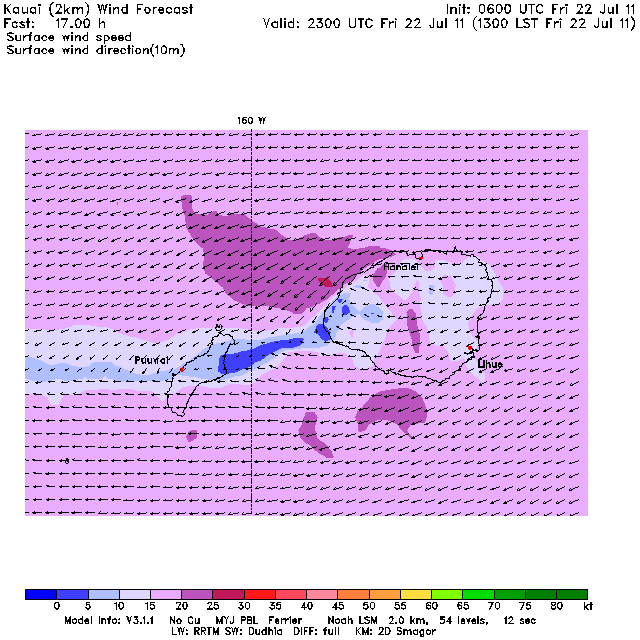
A graphical wind forecast for 1 PM HST July 23, 2011, showing how narrow the “lee” becomes as the day progresses. Like most weather forecasts, this one isn’t particularly accurate, instead of winds <10 knots at 1 PM, it was blowing ~15 knots by about noon.
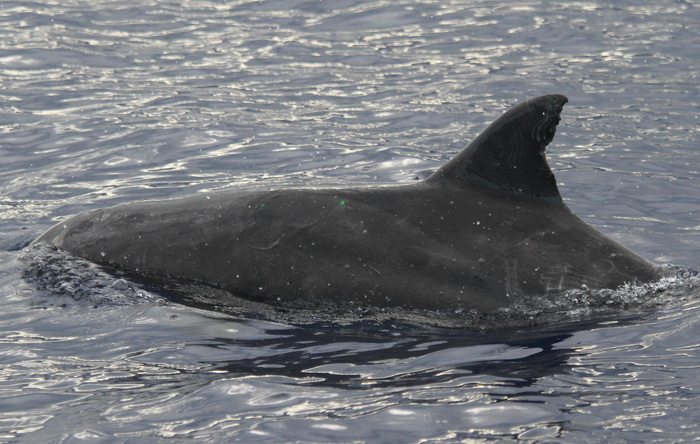
A rough-toothed dolphin, July 23, 2011 showing the types of scars and notches used to identify individuals. Photo by Jochen Zaeschmar. Today we responded to five different posits (see below), and found two different groups, both of rough-toothed dolphins. There were also beaked whales and sperm whales detected acoustically, but those groups were well outside our range far offshore. For more information on rough-toothed dolphins in Hawai‘i see our web page on this species.
July 22 update
Although much windier today than yesterday we still had a productive day, with three encounters, two with bottlenose dolphins and one with spinner dolphins. We were able to photo-identify all the bottlenose dolphins and most of the spinner dolphins, and also collected two biopsy samples from the bottlenose dolphins for genetics and toxicology.
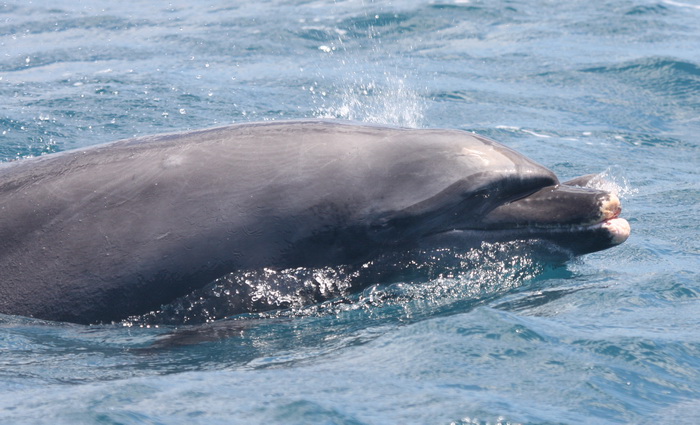
A very robust bottlenose dolphin with injured rostrum, July 22, 2011. Photo by Renee Albertson.
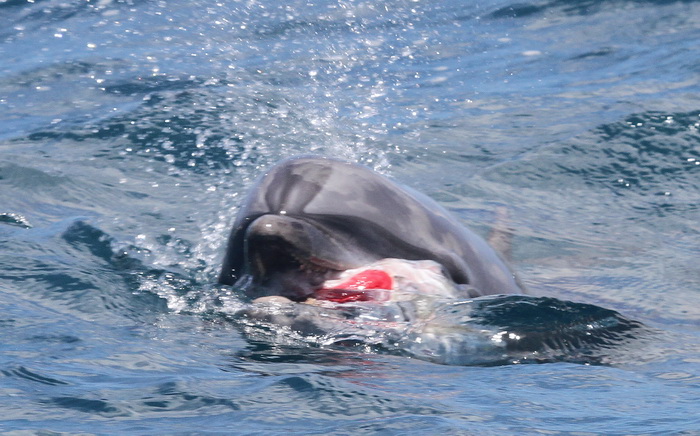
Bottlenose dolphin with fish, July 22, 2011. Photo by Elisa Weiss.
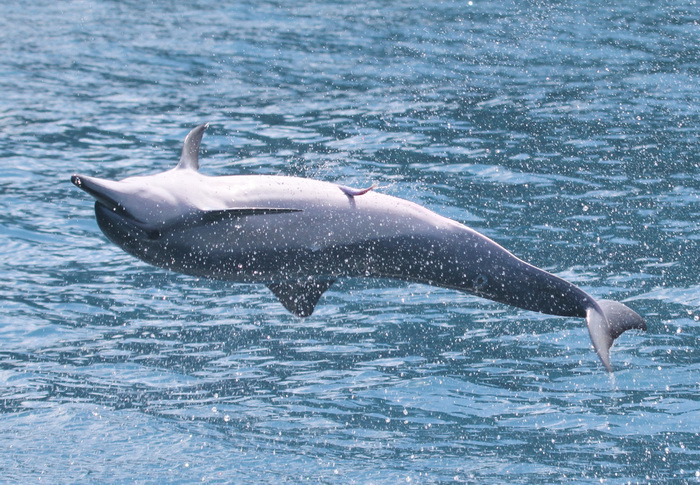
A spinner dolphin spinning, to try to dislodge a remora, July 22, 2011. Photo by Elisa Weiss. Most of the time we get good photographs of spinner dolphins spinning they have remoras that they appear to be trying to get rid of.
July 21 update
Although our first day on the water was supposed to be yesterday, mechanical problems with our research boat prevented us from getting out on the water. We did make it out this morning and were able to spend the morning on the range. Researchers with the M3R program directed us to eight different areas looking for dolphins that they detected acoustically.
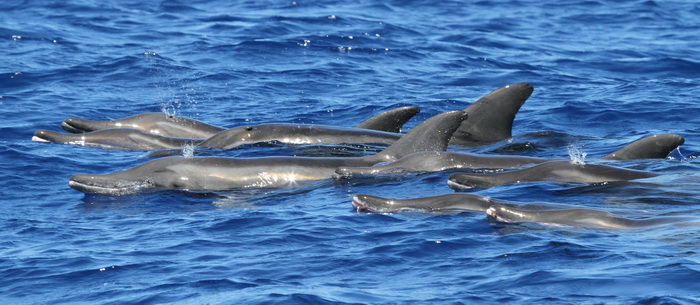
Rough-toothed dolphins, July 21, 2011. Photo by Elisa Weiss. We were able to find dolphins from six of the eight “posits” (short for “positions”), including five groups of rough-toothed dolphins. As well as confirming the species corresponding with the particular acoustic characteristics, we were able to get identification photos of most of the individuals present, and also collected three biopsy samples.
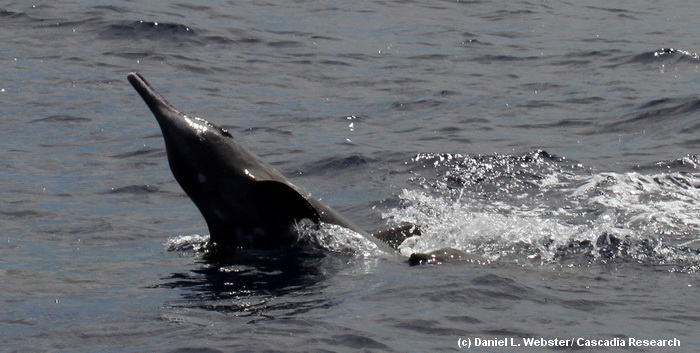
Rough-toothed dolphin, July 21, 2011. Photo by Daniel Webster. The winds today were quite strong (forecast at 20 knots) limiting where and how long we could work, but a very productive day nonetheless!
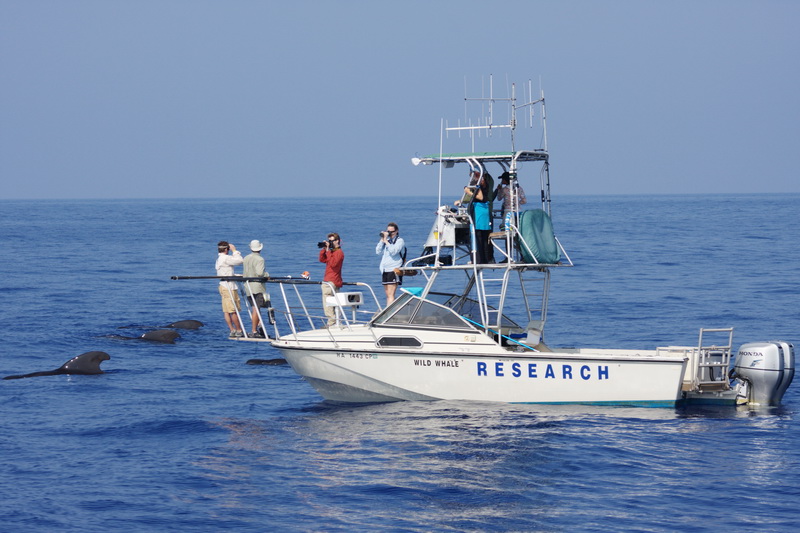
A photo of the research vessel we will be using, the Wild Whale, owned by the Wild Whale Research Foundation based in Holualoa on the island of Hawai‘i. Photo by Elisa Weiss.
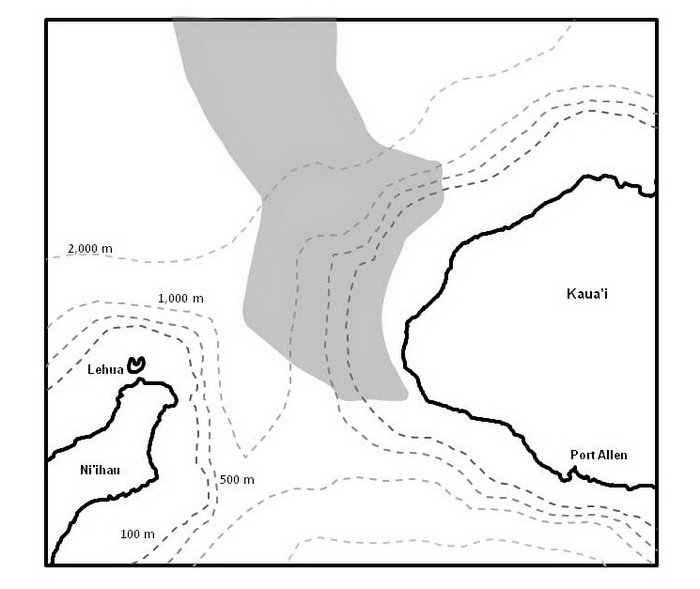
Our study area for the July/August project. The Navy’s hydrophone range it shaded – approximately 175 hydrophones are spread across the shaded area connected to the M3R system.
Sign up to our Facebook page if you want to receive notices of when information is posted and updates on other Cascadia projects.
For more information see our Hawai‘i odontocete research page
See reports from our previous field projects at Hawai‘i field project web page